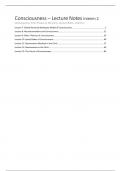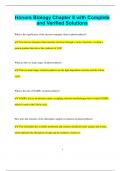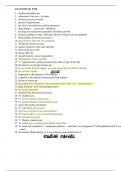MANUAL
Nora Underwood
University of Central Florida
, CONTENTS
P A R T 1: Introduction: Markets and Prices
Chapter 1 Preliminaries 1
Chapter 2 The Basics Of Supply And Demand 5
P A R T 2: Producers, Consumers, and Competitive Markets
Chapter 3 Consumer Behavior 23
Chapter 4 Individual And Market Demand 41
Chapter 4 Appendix 58
Chapter 5 Uncertainty and Consumer Behavior 64
Chapter 6 Production 74
Chapter 7 The Cost Of Production 84
Chapter 7 Appendix 98
Chapter 8 Profit Maximization And Competitive Supply 102
Chapter 9 The Analysis Of Competitive Markets 117
P A R T 3: Market Structure and Competitive Strategy
Chapter 10 Market Power: Monopoly and Monopsony 138
Chapter 11 Pricing With Market Power 160
Chapter 11 Appendix 185
Chapter 12 Monopolistic Competition And Oligopoly 191
Chapter 13 Game Theory And Competitive Strategy 217
Chapter 14 Markets For Factor Inputs 232
Chapter 15 Investment, Time, And Capital Markets 242
P A R T 4: Information, Market Failure, and the Role of Government
Chapter 16 General Equilibrium And Economic Efficiency 255
Chapter 17 Markets With Asymmetric Information 267
Chapter 18 Externalities And Public Goods 278
, Chapter 1: Preliminaries
PART I
INTRODUCTION:
MARKETS AND PRICES
CHAPTER 1
PRELIMINARIES
TEACHING NOTES
The first two chapters reacquaint students with the microeconomics that they learned in their
introductory course: Chapter 1 focuses on the general subject of economics, while Chapter 2 develops
supply and demand analysis. The use of examples in Chapter 1 facilitates students’ complete
understanding of abstract economic concepts. Examples in this chapter discuss markets for
prescription drugs (Section 1.2), introduction of a new automobile (Section 1.4), design of automobile
emission standards (Section 1.4), the minimum wage (Section 1.3), the market for sweeteners (Section
1.3), and real and nominal prices of eggs and education (Section 1.3). Discussing some of these, or
another, example is a useful way to review some important economic concepts such as scarcity, making
tradeoffs, building economic models to explain how consumers and firms make decisions, and the
distinction between competitive and non-competitive markets. Parts I and II of the text assume
competitive markets, market power is discussed in Part III, and some consequences of market power
are discussed in Part IV of the text.
Review Question (2) illustrates the difference between positive and normative economics and
provides for a productive class discussion. Other examples for discussion are available in Kearl, Pope,
Whiting, and Wimmer, “A Confusion of Economists,” American Economic Review (May 1979).
The chapter concludes with a discussion of real and nominal prices. Given our reliance on
dollar prices in the chapters that follow, students should understand that we are concerned with prices
relative to a standard, which in this case is dollars for a particular year.
QUESTIONS FOR REVIEW
1. It is often said that a good theory is one that can be refuted by an empirical, data-
oriented study. Explain why a theory that cannot be evaluated empirically is not a good
theory.
There are two steps to consider when evaluating a theory: first, you should examine the
reasonability of the theory’s assumptions; second, you should test the theory’s
predictions by comparing them with facts. If a theory cannot be tested, it cannot be
accepted or rejected. Therefore, it contributes little to our understanding of reality.
2. Which of the following two statements involves positive economic analysis and which
normative? How do the two kinds of analysis differ?
a. Gasoline rationing (allocating to each individual a maximum amount of gasoline
that can be purchased each year) is a poor social policy because it interferes with
the workings of the competitive market system.
Positive economic analysis describes what is. Normative economic analysis describes
what ought to be. Statement (a) merges both types of analysis. First, statement (a)
makes a positive statement that gasoline rationing “interferes with the workings of the
competitive market system.” We know from economic analysis that a constraint placed
on supply will change the market equilibrium. Second, statement (a) makes the
normative statement (i.e., a value judgment) that gasoline rationing is a “poor social
policy.” Thus, statement (a) makes a normative comment based on a conclusion derived
from positive economic analysis of the policy.
1
, Chapter 1: Preliminaries
b. Gasoline rationing is a policy under which more people are made worse off than are
made better off.
Statement (b) is positive because it states what the effect of gasoline rationing is
without making a value judgment about the desirability of the rationing policy.
3. Suppose the price of unleaded regular octane gasoline were 20 cents per gallon higher in
New Jersey than in Oklahoma. Do you think there would be an opportunity for arbitrage
(i.e., that firms could buy gas in Oklahoma and then sell it at a profit in New Jersey)? Why
or why not?
Oklahoma and New Jersey represent separate geographic markets for gasoline because
of high transportation costs. If transportation costs were zero, a price increase in New
Jersey would prompt arbitrageurs to buy gasoline in Oklahoma and sell it in New
Jersey. It is unlikely in this case that the 20 cents per gallon difference in costs would
be high enough to create a profitable opportunity for arbitrage, given both transactions
costs and transportation costs.
4. In Example 1.3, what economic forces explain why the real price of eggs has fallen while
the real price of a college education has increased? How have these changes affected
consumer choices?
The price and quantity of goods (e.g., eggs) and services (e.g., a college education) are
determined by the interaction of supply and demand. The real price of eggs fell from
1970 to 1985 because of either a reduction in demand (consumers switched to lower-
cholesterol food), a reduction in production costs (improvements in egg production
technology), or both. In response, the price of eggs relative to other foods decreased.
The real price of a college education rose because of either an increase in demand (e.g.,
more people recognized the value of an education), an increase in the cost of education
(e.g., increase in staff salaries), or both.
5. Suppose that the Japanese yen rises against the U.S. dollar- that is, it will take more
dollars to buy any given amount of Japanese yen. Explain why this increase
simultaneously increases the real price of Japanese cars for U.S. consumers and lowers the
real price of U.S. automobiles for Japanese consumers.
As the value of the yen grows relative to the dollar, more dollars exchange for fewer
yen. Assume that the costs of production for both Japanese and U.S. automobiles
remain unchanged. Then using the new exchange rate, the purchase of a Japanese
automobile priced in yen requires more dollars. Similarly, the purchase of a U.S.
automobile priced in dollars requires fewer yen.
6. The price of long-distance telephone service fell from 40 cents per minute in 1996 to 22
cents per minute in 1999, a 45-percent (18 cents/40 cents) decrease. The Consumer Price
Index increased by 10-percent over this period. What happened to the real price of
telephone service?
Let the CPI for 1996 equal 1 and the CPI for 1999 equal 1.1, which reflects a 10%
increase in the overall price level. To find the real price of telephone service in each
period, divide the nominal price by the CPI for that year. For 1996, we have 40/1 or 40
cents, and for 1999, we have 22/1.1 or 20 cents. The real price therefore fell from 40 to
20 cents, a 50% decline.
2




